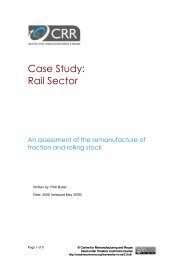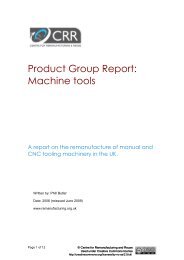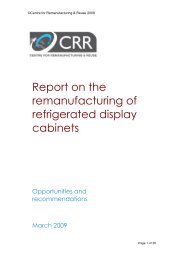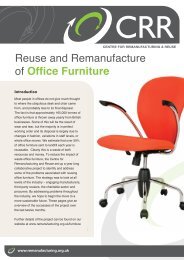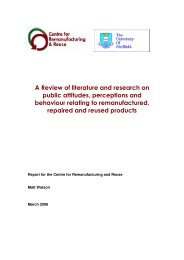automotive reman - Centre for Remanufacturing & Reuse
automotive reman - Centre for Remanufacturing & Reuse
automotive reman - Centre for Remanufacturing & Reuse
Create successful ePaper yourself
Turn your PDF publications into a flip-book with our unique Google optimized e-Paper software.
Technical University of BerlinInstitute <strong>for</strong> Machine Toolsand Manufacturing Technology (IWF)Automotive <strong>Remanufacturing</strong>in Europe:Survey ResultsConducted by Technische Universität Berlin(September – October 2007)bySemih SeverengizCagin SezginKuo-Hsiang YongBerlin, January 2008Institute <strong>for</strong> Machine Tools and Manufacturing Technology (IWF)
Automotive <strong>Remanufacturing</strong> in Europe: Survey ResultsIIAcknowledgementsWe would like to convey our heartfelt thanks to all respondents <strong>for</strong> their valuableinputs and comments.We would also like to thank Ms Fiona Kelday from the Center <strong>for</strong> <strong>Remanufacturing</strong>and <strong>Reuse</strong> (CRR) who <strong>for</strong>warded the survey by email on to an undisclosed numberof members. Without her kind assistance the survey would not have been possible.Institute <strong>for</strong> Machine Tools and Manufacturing Technology (IWF)
Automotive <strong>Remanufacturing</strong> in Europe: Survey ResultsIIIContentPage1. INTRODUCTION................................................................................................................12. SURVEY RESULTS AND ANALYSIS............................................................................12.1 Cross Section of Respondents ............................................................................22.2 Company Growth ...................................................................................................32.3 Export.......................................................................................................................42.4 Analysis of Cores ...................................................................................................52.5 Analysis of Processes ...........................................................................................82.6 Standards..............................................................................................................112.7 Regulations ...........................................................................................................112.8 Innovation..............................................................................................................143. SUMMARY........................................................................................................................14List of FiguresFigure 1 Total Number of Employees...................................................................................2Figure 2 Growth <strong>for</strong> All Products ...........................................................................................3Figure 3 Growth <strong>for</strong> Reman Products...................................................................................3Figure 4 Respondents' Export <strong>for</strong> all Products....................................................................4Figure 5 Respondents' Export <strong>for</strong> <strong>Remanufacturing</strong> Products .........................................4Figure 6 Production Volumes of Remanufactured Components......................................5Figure 7 Average age of Remanufactured Automotive Components..............................6Figure 8 Percentage of Cores collected which are not <strong>reman</strong>ufacturable......................7Figure 9 Individual Processes shown as Percentage of entire <strong>Remanufacturing</strong>Process..............................................................................................................................9Figure 10 Level of Difficulty of Individual Processes........................................................10Figure 11 Effect of Regulations on various cost structures.............................................13Institute <strong>for</strong> Machine Tools and Manufacturing Technology (IWF)
Automotive <strong>Remanufacturing</strong> in Europe: Survey Results11. INTRODUCTIONAs the earth’s resources are slowly being depleted by human activities, especiallyby production industries, sustainable development has become an importanteconomic and environmental theme. Sustainable development can be defined asthe development that "meets the needs of the present without compromising theability of future generations to meet their own needs." (Brundtland Commission,UN) In the spirit of sustainability, this topic is focuses on <strong>Remanufacturing</strong> inEurope, especially Germany, France and the UK, and how it is a critical enabler ofsustainability.The survey was created by the Institute of Machine Tools and FactoryManagement (IWF), located at the Production and Technology Center (PTZ) of theTechnische Universität Berlin (TUB) and was conducted during the period ofSeptember and October 2007. The survey was distributed to <strong>reman</strong>ufacturers inGermany, France and the United Kingdom. Additional distribution was provided bythe Center <strong>for</strong> <strong>Remanufacturing</strong> and <strong>Reuse</strong> (CRR) who <strong>for</strong>warded the survey byemail on to an undisclosed number of members. The aim of the survey is togenerate industrial data to facilitate an economic understanding of European<strong>reman</strong>ufacturing, while gaining an appreciation <strong>for</strong> some of the problems andissues the industry is facing, such as legislations.The target group, <strong>for</strong> which the questionnaire is intended, is <strong>reman</strong>ufacturers of<strong>automotive</strong> components, who also engage in the reconditioning process, and notjust collection and redistribution. The data will be interpreted with respect to theliterature reviewed and special attention will be given to trend spotting <strong>for</strong> thepresent and future.With the support of various organizations and companies from the European<strong>automotive</strong> industry, this survey captured a variety of in<strong>for</strong>mation with regards tothe challenges the <strong>reman</strong>ufacturing business face. In this report, we present thesurvey results of our <strong>reman</strong>ufacturing questionnaire.2. SURVEY RESULTS AND ANALYSIS60 companies from Germany, France and the United Kingdom were contacted viaemail to request <strong>for</strong> their participation, of which 12 replies were received. Thetarget group, <strong>for</strong> which the questionnaire is intended, is <strong>reman</strong>ufacturers of<strong>automotive</strong> components, who also engage in the reconditioning process, and notjust collection and redistribution. Where appropriate, the data will be interpretedboth quantitatively and qualitatively, and in the context of the study.Institute <strong>for</strong> Machine Tools and Manufacturing Technology (IWF)
Automotive <strong>Remanufacturing</strong> in Europe: Survey Results22.1 Cross Section of RespondentsAll the respondents were identified as either a limited or private limited company.However, as some of the respondents have elected to remain anonymous, ananalysis of the data with respect to the countries surveyed is not possible.The total number of employees in the respondent pool is illustrated in Figure 1,which also shows that many of the respondents (75%) are small and mediumenterprises. As expected, the smallest company, with 10-20 employees, wascompletely engaged in <strong>reman</strong>ufacturing. Among the next group of 3 respondentsin the category of having 50-99 employees, 1 company was completely engaged in<strong>reman</strong>ufacturing, while the other 2 reported having about 50% of employeesengaged in <strong>reman</strong>ufacturing. These respondents are producers and<strong>reman</strong>ufacturers in a variety of products including alternators, starter motors,engines, transmissions and steering hydraulics. These 2 groups can beconsidered small enterprises and hence it is noteworthy that the small enterprisesare also able to produce new products and <strong>reman</strong>ufacture old ones in almostequal share.54Number of Respondents321010-20 50-99 100-249 >500Total Number of EmployeesFigure 1 Total Number of EmployeesIn the next group of respondents in the category of having 100-249 employees,only 1 company had more than 50% of their employees engaged in<strong>reman</strong>ufacturing, while the other 4 had 30% or less. The respondents reportedlyInstitute <strong>for</strong> Machine Tools and Manufacturing Technology (IWF)
Automotive <strong>Remanufacturing</strong> in Europe: Survey Results4v. All the large companies with more than 500 employees reported less 5%growth <strong>for</strong> <strong>reman</strong>ufactured products, with 1 company reporting negativegrowth.It is evident from these observations that growth throughout the <strong>reman</strong>ufacturingindustry is irregular and likely to be a function of the product selected <strong>for</strong><strong>reman</strong>ufacturing as well as the company’s logistics capabilities to acquire cores. Itis observed that larger companies appear to be faring less well in the field of<strong>reman</strong>ufacturing.2.3 ExportFigure 4 illustrates the export estimate figures of all products <strong>for</strong> the surveyrespondents and indicates that export <strong>for</strong>ms an important part of their businesses,with more than half of the respondents exporting more than 20% of theirproduction. Only 1 respondent reported that export is less than 5%. The samecompany is one of the smallest that responded to our survey, with 10-19employees.Figure 5 shows the export estimates <strong>for</strong> the same companies but <strong>for</strong><strong>reman</strong>ufactured products alone and indicates that many of the respondents exportonly a very small percentage of their production, if any at all. The majority ofrespondents export their products mainly to eastern and western Europe, with afew exporting to Scandinavia, Far East and Russia as well. The reason that somany of the respondents have such low export figures is possibly that there existinternational restrictions on the trade of <strong>reman</strong>ufactured goods. Such barriers mayinclude outright import bans, higher tariffs and fees or over-stringent regulations,certifications and incoming inspection criteria.Number of Respondents432100-5 10-19 20-49 >50Percentage ofall Products exportedNumber of Respondents65432100-5 10-19 20-49 >50Percentage of RemanufacturedProducts exportedFigure 4 Respondents' Export <strong>for</strong> all ProductsFigure 5 Respondents' Export <strong>for</strong> Remanufactured ProductsIt is likely that many of these barriers occur as a result of come countries, perhapsmistakenly, associating <strong>reman</strong>ufactured goods with used goods and waste. SomeInstitute <strong>for</strong> Machine Tools and Manufacturing Technology (IWF)
Automotive <strong>Remanufacturing</strong> in Europe: Survey Results5countries have already proposed that <strong>reman</strong>ufactured goods not be regarded assuch, but instead receive trade treatment similar to new products 1 .The liberalization of trade in <strong>reman</strong>ufactured goods may offer many additionalbenefits to developing countries, such as the opportunities to use capital goodsthat incorporate advanced technology at reduced rates. The elimination of tradebarriers in <strong>reman</strong>ufactured goods may enlarge market choices.2.4 Analysis of CoresAll respondents were engaged in <strong>reman</strong>ufacturing without loss of identity, except<strong>for</strong> 1 engaged in engines, gearboxes and fuel pumps. An analysis of the cores canbe carried out by examining the average age of the cores, the percentage of non<strong>reman</strong>ufacturablecores and production volume/year of components surveyed. Theideal <strong>reman</strong>ufactured product would have a high production volume, low age uponcollection (relative to warranty period), ease of disassembly and reassembly, lowscrap rate as well as a long technology/innovation cycle.Referring to Figure 6, of the components surveyed, alternator and starter motorsare ideal candidates <strong>for</strong> a profitable <strong>reman</strong>ufacturing endeavour, as these 2components have very high production volumes and low un-manufacturability.6000050000Volume in units400003000020000100000Starter MotorAlternatorAxle ShaftEngineTransmissionClutch CoverAssemblyAirCompressorPneumaticSpring BrakeAir DryerClutch PlatesFigure 6 Production Volumes of Remanufactured Components1 Market Access <strong>for</strong> Non-Agricultural Products: Negotiating NTB’s related to <strong>Remanufacturing</strong> andRefurbishing. World Trade Organization, 2005Institute <strong>for</strong> Machine Tools and Manufacturing Technology (IWF)
Automotive <strong>Remanufacturing</strong> in Europe: Survey Results6A cross section of the average age of all <strong>reman</strong>ufactured components reported inthe survey is illustrated in Figure 7. Cores that are collected are typically youngerthan their average life expectancy. For example, the alternator has a life span ofabout 10 years or 110000miles. (The average life span of a car is about 13 yearsor 145000miles).It is also interesting to note that, as previously mentioned, a new car has awarranty period of 3 years, while collected cores such as the engine andtransmission are typically about 2.5 years to 4.5 years old upon collection. Mostengines, serviced according to the owner’s manual, will last longer than the rest ofthe car; frequently 250000-300000 miles or about 26 years. A transmission will last140000-200000 miles, and in comparison with the warranty period of 3 years, thecomponents are considerably young.87Core Age in years6543210Starter MotorAlternatorAxle ShaftEngineTransmissionClutch CoverAssemblyAirCompressorPneumaticSpring BrakeAir DryerClutch PlatesFigure 7 Average age of Remanufactured Automotive ComponentsIt is possible that these cores are so young upon collection because they are newdesigns with early burning-in “infant mortality” defects at the beginning of the“bath-tub” curve.This has 2 implications:Institute <strong>for</strong> Machine Tools and Manufacturing Technology (IWF)
Automotive <strong>Remanufacturing</strong> in Europe: Survey Results7i. These components have a technology/innovation cycle that is as long asthe car itself, unlike components such as starter motors and alternatorswhich have a much longer cycle, which enable them the same designsto be used repeatedly <strong>for</strong> new vehicle designs of simply design updates.ii.If these cores are indeed new designs with “burning-in” defects at thebeginning of the “bath-tub” curve, the supply of cores will decrease overtime as production moves towards the middle of the curve during theperiod of constant (random) failures with fewer defects.Lastly, the percentage of cores that are not <strong>reman</strong>ufacturable offers anotherinsight into the product-specific business models. Figure 8 shows the percentageof collected cores which are not <strong>reman</strong>ufacturable. According to the respondents,axle shafts have the lowest percentage, followed by transmissions and air dryers.Starter motors, alternators, engines and spring brakes have the same scrap rate of10-15%. Clutch cover assembly and air compressors have a scrap rate of 20%while clutch plates have the highest at 30%.Percentage of Cores not <strong>reman</strong>ufacturable (%)302520151050Starter MotorAlternatorAxle ShaftEngineTransmissionClutch CoverAssemblyAirCompressorPneumaticSpring BrakeAir DryerClutch PlatesFigure 8 Percentage of Cores collected which are not <strong>reman</strong>ufacturableInstitute <strong>for</strong> Machine Tools and Manufacturing Technology (IWF)
Automotive <strong>Remanufacturing</strong> in Europe: Survey Results82.5 Analysis of ProcessesRespondents were also posed questions regarding to their manufacturingprocesses, among which the ability to produce <strong>reman</strong>ufactured and new productson the same production line was of particular interest. Out of the 12 respondents,only 3 were able to do so; 1 SME was able to do so <strong>for</strong> 5% of all products, while 1large company, or Multi-National Corporation (MNC), was able to do so <strong>for</strong> 50% ofthe time. Only 1 MNC was able to produce both <strong>reman</strong>ufactured and new productson the same production line.A producer’s ability to manufacture new and <strong>reman</strong>ufactured products on the sameproduction time depends largely on the design of the product as well as themanufacturing processes.Every production line experiences defects and scrap, and have in a place some<strong>for</strong>m of Quality Acceptance Criteria (QAC), which determines if a product can bere-worked, or has to be scrapped. Rework, while still considered a cost of quality,retains more product value in the value chain than directly scrapping a defectiveproduct. In order to reduce the rework costs, production lines typically employinnovation and lean principles in their approach towards rework. Products due <strong>for</strong>rework are typically re-introduced somewhere into the manufacturing process andjoin a batch of new products. Sometimes major modifications or minor tweaks maybe implemented on manufacturing processes to enable a mainstream rework ofdefective products, thus removing the necessity of a separate process, product orwork flow just <strong>for</strong> <strong>reman</strong>ufactured products.However, the limitation of this method depends largely on product and processdesign, and whether a product is suitably compatible with a production line as toemploy this method. Remanufactured products may be the only viable source ofspares after a product have been phased out, but more so, after the productionline has been torn down to make way <strong>for</strong> new products.The ability of a <strong>reman</strong>ufactured product to be produced on the same line as a newproduct depends on whether both product belong to the same technology cycle.From a manufacturing perspective, the innovation cycle of the product hasimplications <strong>for</strong> the production line, in terms of design changes and how thesechanges will prevent a <strong>reman</strong>ufactured product from being produced on the sameline.Institute <strong>for</strong> Machine Tools and Manufacturing Technology (IWF)
Automotive <strong>Remanufacturing</strong> in Europe: Survey Results9Figure 9 Individual Processes shown as Percentage of entire <strong>Remanufacturing</strong>ProcessThe processes are also considered in terms of the level of difficulty and theamount of time each process takes, relative to the entire <strong>reman</strong>ufacturing process.All the respondents who were surveyed indicated that they were engaged in the 6<strong>reman</strong>ufacturing processes outlined in Figure 5, as well as collection.Subsequently, they were asked more detailed questions with regards to eachprocess in terms of how much time each process takes (Figure 9) and howchallenging these processes were (Figure 10). When these 2 figures areconsidered together, several observations may be made:i. While almost all respondents agree that collection takes the leastamount of time (0-19%), several respondents have described thecollection process to be somewhat of a challenge. However there is notrend that pertains to the type of product <strong>reman</strong>ufactured that couldexplain this phenomenon, which can only be attributed to availability.Institute <strong>for</strong> Machine Tools and Manufacturing Technology (IWF)
Automotive <strong>Remanufacturing</strong> in Europe: Survey Results10Figure 10 Level of Difficulty of Individual Processesii.iii.iv.According to the respondents, disassembly enjoys both low processingtime and minimal difficulty encountered.The response to the cleaning process is similar to the response tocollection, except more respondents find the cleaning process to be “nota problem at all.”Inspection appears to be a relatively easy and short process, withalmost all respondents describing it to be neutral to “not a problem at all”and take 20-39% of the time or less. This is also a critical phase where adecision is made as to whether a core is <strong>reman</strong>ufacturable or not. Clearquality standards and protocols need to be adhered to at this stage.Some preliminary testing may also be incorporated at this stage to aid inthe decision making process.v. Both reconditioning and reassembly are time-consuming processes, butrespondents do not generally encounter difficulties with theseprocesses, and only 1 respondent described reconditioning to be asevere challenge.vi.Lastly, survey response shows that testing takes mostly 0-19% of thetime, but had several respondents describe it to be somewhat of aInstitute <strong>for</strong> Machine Tools and Manufacturing Technology (IWF)
Automotive <strong>Remanufacturing</strong> in Europe: Survey Results11challenge. The challenge here is to develop a method, or perhaps use astandard method to test a <strong>reman</strong>ufactured product and interpret theresults conclusively such that the product will fulfill the warrantyguaranteed by the <strong>reman</strong>ufacturer to a high level of confidence.Remanufacturers will have to contend with various warranty costs andscrap decisions.Generally, it would appear that most of the respondents do not encounter manyserious technical issues with respect to the <strong>reman</strong>ufacturing process.2.6 StandardsFrom follow-up discussions with some respondents, standards, while thebenchmark amongst all MNCs, are not always implemented, especially amongstthe very small companies, due to a variety of reasons, as will be discussed shortly.The survey also attempted to briefly find out where the survey respondents standon the issue of standards.The majority of the respondents is acquainted with, and most employ, ISO 9000 aswell as the ISO 14000 standards, although there are a few exceptions. ISOcertification may sometimes serve only as a guide <strong>for</strong> the minimum standard to bemaintained in an enterprise. One respondent had allowed their subscription to theISO9001 accreditation to lapse, while still maintaining the high technical standardsthat were employed during their participation. They also have a working groupwithin the company that effects all the changes and constantly develop thesesystems and procedures.Many <strong>reman</strong>ufacturers belong to the SME category, often from the small spectrumof that classification. For many of these small enterprises, it may not be financiallysound to maintain a costly ISO accreditation subscription. Thus, they may chooseto renew their accreditation less frequently, or obtain an accreditation as a onetimeef<strong>for</strong>t or simply not subscribe to ISO certification and obtain other means ofrecognition, such as fulfilling the quality requirements of customers.2.7 RegulationsThe European Community’s intention with the revised Block Exemption Regulation(BER) is to ensure that consumers receive a more equitable return on theirinvestment beyond the initial purchase of the vehicle, but also the continualinvestment in terms of after-sales services. The BER also seeks to level theplaying field by giving dealers more independence from Vehicle Manufacturers(VM) and liberalising the provision of after-sales services and the procurement ofInstitute <strong>for</strong> Machine Tools and Manufacturing Technology (IWF)
Automotive <strong>Remanufacturing</strong> in Europe: Survey Results12spare parts. VMs are also required to provide equal access to technicalin<strong>for</strong>mation, including in<strong>for</strong>mation pertaining to training, software, tools andequipment, <strong>for</strong> all operators involved in repair, training or technical assistance,regardless of whether they are authorised or independent repairers. Further, theburden of proof falls squarely on the shoulders of the VM that the VM has been fairto these players 2 .One of the most conspicuous results from the survey was that 75% of therespondents are familiar with End of Life Vehicle (ELV), while only 30% arefamiliar with BER. While these regulations and legislation are passed by the EC,the EC is not doing enough to ensure that all the players, especially the smallerplayers, are duly and timely in<strong>for</strong>med of these regulations. This evidently goesagainst the very intention of the BER, which was to level the playing field. As 1respondent commented,“Existing regulations need to be strictly en<strong>for</strong>ced, so all suppliers have alevel playing field.”This is also in agreement with the PWC report 3 18 months after theimplementation of the BER: the BER has not achieved much. Even though theafter-sales services and procurement of spare parts have been liberalized, thereactions of the independent repairers (including <strong>reman</strong>ufacturers) have beenlukewarm at best: independent players are not particularly eager to becomeauthorised by the VMs.Without ensuring that all players are duly in<strong>for</strong>med and educated with regards tothe newly ratified regulations, the onus is placed on the <strong>automotive</strong> players to keepup to date. As another respondent commented,“We are in a constant battle to remain fully up to date with specificationsand diagnostic data relating to VM Major Automotive Units and VehicleElectrical Management systems. The implementation of varying degrees ofBER has brought to bear some improvement and benefit to the <strong>automotive</strong>aftermarket sector. This still falls a lot short of where the BE regulationswere originally perceived to be heading and in other markets around theworld, this restrictive trade barrier is less evident.”This is also in agreement with a comment made by a respondent in a separatesurvey,2 Price Waterhouse Coopers. Gentlemen’s dispute or bar room brawl. Part 1: The impact of the newblock exemption regulation on carmakers. 2003.3 Price Waterhouse Coopers. Bar room brawl spills onto the streets. 2005.Institute <strong>for</strong> Machine Tools and Manufacturing Technology (IWF)
Automotive <strong>Remanufacturing</strong> in Europe: Survey Results13“Legislation is one of my concerns as you setup <strong>for</strong> new laws and theycome back with something else to do, but without help financially to copewith the extra work load 4 .”Increase in Cost Structure No Change in Cost Structure Decrease in Cost StructureNumber of Respondents109876543210Labour Material Technological/R&D InvestmentQuality Logistics Process Sales/RevenuesFigure 11 Effect of Regulations on various cost structuresAs previously mentioned, the burden of proof falls squarely on the shoulders of theVM to be candid and transparent with regards to providing equal access totechnical in<strong>for</strong>mation, but without guidelines to assist the implementation of equaltechnical access nor legal framework that provides <strong>for</strong> the smaller players, theobjectives that the BER regulations set out to achieve would never be realized.Respondents were also queried regarding the effect of the regulations on variouscost structures.As previously discussed, the ELV directive will require close collaboration betweenproducers and downstream partners in order to achieve targets and reduce costs,as well as an increase in professional requirements. The latter impact on theindustry is likely to drive some small players out of business, resulting inconsolidation, which poses the greatest concern <strong>for</strong> small and medium enterprises.As a result of these regulations, respondents have reported an overall increase incosts, as illustrated by Figure 11. Respondents who answered the question withactual values reported 5% increase in costs across labour, material and techinvestment and 2% in logistics. No change in quality and process costs wasobserved. All but 1 respondent reported increase in sales and revenue, and wasthe same respondent who reported an increase in growth of between 20-49% <strong>for</strong><strong>reman</strong>ufactured products alone. It is believed that the company has closely4 Gareth Coates. An Authorised Treatment Facility Survey: Issues and trends within the vehiclerecovery sector. Sustainable Manufacturing and <strong>Reuse</strong>/Recycling Technologies (SMART),Loughborough University. July 2007.Institute <strong>for</strong> Machine Tools and Manufacturing Technology (IWF)
Automotive <strong>Remanufacturing</strong> in Europe: Survey Results14followed developments in the regulations and has managed to successfully takeadvantage of the liberalization of the after-sales market as well as the proposedequal access to VM technical in<strong>for</strong>mation.2.8 InnovationFrom the survey, only 1 respondent responded to owning a patent <strong>for</strong> either a<strong>reman</strong>ufacturing product or process.However, there is a scope <strong>for</strong> technological advancements which should beexplored. Remanufacturers have a wealth of knowledge that is not available toVMs and, to a lesser extent, Original Equipment Manufacturers (OEM), which canbe harnessed <strong>for</strong> innovation. Patents that benefit VMs and OEMs may be leasedor sold to them at a margin. VMs may also make specialized or integrated designchanges, such that only they can manufacture the components, or make it moredifficult to disassemble and/or reassemble. Remanufacturers may file defensivepatents to prevent VMs from making design changes that affect them negatively.From the point of view of the <strong>reman</strong>ufacturing respondents, Research andDevelopment (R&D) is not a top priority. However there is huge scope <strong>for</strong>technological advancements in the field of disassembly and reconditioning, whichhas yet to be explored. Generally, reconditioning is a labour intensive activitywhich provides an opportunity <strong>for</strong> automation.Indeed, the feasibility of investing in this area depends on the life cycle analysis 5 ,in particular the innovation cycle, of the individual component relative to theproduct innovation cycle. For any one car, the production run, from start to end ofproduction, may last about 4 years in the case of the Toyota Corolla which wasproduced from 1966-1997 and had 9 generations 6 . The average life span of a caris about 13 years or 145000miles. In comparison, an alternator has a life span ofabout 10 years or 110000miles.3. SUMMARYThe survey showed, among other issues, that legislation may be the only means ofcreating a shift in the paradigm, where VMs still maintain substantial influence overthe <strong>reman</strong>ufacturing market, and business strategies would do well to take intoconsideration future take-back and recovery legislation. This could well turn into acompetitive advantage <strong>for</strong> the business. However, any pre-emptive strategy also5 Seitz M.A.. Understanding closed-loop supply chain management: a theoretical discussion.BRASS. Working Paper Series No. 25. 20056 World’s 5 most successful cars. www.cartype.comInstitute <strong>for</strong> Machine Tools and Manufacturing Technology (IWF)
Automotive <strong>Remanufacturing</strong> in Europe: Survey Results15depends on <strong>for</strong>ecasting how the industry will react, and the subsequent commonindustrial practice, as well as the reaction of the market itself. At the same time, itis necessary <strong>for</strong> legislation to look beyond the VMs and consider how<strong>reman</strong>ufacturers will be affected by frequent and substantial legislative changes.Institute <strong>for</strong> Machine Tools and Manufacturing Technology (IWF)
Automotive <strong>Remanufacturing</strong> in Europe: Survey ResultsIAppendix A Questionnaire <strong>for</strong> Experts in Re-ManufacturingQuestionnaire <strong>for</strong> Experts in RE-MANUFACTURINGThis questionnaire is a part of a comprehensive research project on European<strong>reman</strong>ufacturing activities in the <strong>automotive</strong> industry, especially in UK, Germany andFrance and will address how <strong>reman</strong>ufacturing is managed in Europe, in terms ofbusiness structures and models, and the impacts of regulations and legislations onthe <strong>reman</strong>ufacturing market.As the earth’s resources are slowly being consumed by human activities, sustainabledevelopment has become an important economic and environmental theme. Today,<strong>reman</strong>ufacturing is an important means in preserving the resources such as rawmaterials and energy. <strong>Remanufacturing</strong> is defined as a series of manufacturing stepsacting on an end-of-life part or product in order to return it to like-new conditions orbetter per<strong>for</strong>mance, with warranty to match. It sometimes requires the repair orreplacement of worn out or obsolete components and modules. A <strong>reman</strong>ufacturedproduct should match the same customer expectation as new product.With your support, this survey will examine what challenges the <strong>reman</strong>ufacturingbusiness face and thereby identify their needs. This questionnaire is <strong>for</strong> companiesengaged in <strong>automotive</strong> <strong>reman</strong>ufacturing. Your answers will be kept strictlyconfidential. If you are not certain about an answer, you may estimate or move on tothe next question. We would also be happy to furnish you with a copy of the surveyresults. The questionnaire should not take longer than 15 minutes. Kindly return yourquestionnaires by 9th November 2007.We sincerely thank you <strong>for</strong> your help and support.With best regards from Berlin,Semih Severengiz Kuo-Hsiang, Yong Cagin SezginSenior Engineer Research Engineer Research EngineerIWF TU Berlin IWF TU Berlin IWF TU BerlinInstitute <strong>for</strong> Machine Tools and Manufacturing Technology (IWF)
Automotive <strong>Remanufacturing</strong> in Europe: Survey ResultsIIPlease fill in and/or and mark (√) in following questions.Section 1: General In<strong>for</strong>mation1.1 Is your Company/Organisation classified as:Government ownedPrivately ownedSole Proprietorship Limited (Ltd.) CompanyPartnershipsPrivate Limited (Pte. Ltd.) Company1.2 Number of employees:TotalInvolved in<strong>Remanufacturing</strong>1 - 5 6 - 10 10 – 20 21 – 49 50 – 99 100 - 249 250 -499 > 5001.3 Annual turnover (last financial year):Please indicate currency: Euro Pound(in millions) < 0.1 0.1 - 0.4 0.5 – 0.9 1 – 9 10 – 49 50 – 99 > 100All productsRemanufacturedproducts1.4 Growth (past year):(in percentage) 0 – 5 6 – 9 10 – 19 20 – 49 > 50 Negative GrowthAll productsRemanufacturedproducts1.5 Export (past year):(in percentage) 0 – 5 6 – 9 10 – 19 20 – 49 > 50 Do not ExportAll productsRemanufacturedproductsIf your company does not export, please go to Question 1.7.1.6 To which of the following regions does your company export?South America Russia Eastern EuropeAfricaWestern EuropeOther (please specify)1.7 How would you describe your <strong>reman</strong>ufacturing system?<strong>Remanufacturing</strong> without loss of identity.Repetitive <strong>reman</strong>ufacturing without loss of identity.<strong>Remanufacturing</strong> with loss of original product identity.Other (please specify)Institute <strong>for</strong> Machine Tools and Manufacturing Technology (IWF)
Automotive <strong>Remanufacturing</strong> in Europe: Survey ResultsIIISection 2: Product Engineering2.1 Which of the following <strong>automotive</strong> products do you <strong>reman</strong>ufacture?Starter Motor Alternator Air CompressorC.V. Joint CalliperOthers, please specifyOthers, please specifyOthers, please specify2.2 Please fill in the table below <strong>for</strong> the products you <strong>reman</strong>ufacture.Starter MotorAlternatorAirCompressorC.V. JointCaliperi) How many <strong>reman</strong>ufactured products do youproduce per year? (Volume/year) Please round offto the nearest 100.ii) How old are the core components uponcollection? (years)iii) What percentage of the cores collected is notREMANUFACTURABLE? (%)iv) How many design and/or utility patents do youhave <strong>for</strong>:a) All products and processes?b) REMANUFACTURED products andprocesses only?Please round off to the nearest 10.v) Can you produce <strong>reman</strong>ufactured products onthe same line as new products? (“Y” <strong>for</strong> “Yes, “N”<strong>for</strong> “No”)vi) If your answer above is “YES,” what percentageof a) NEW products are produced on the sameline? (%)b) REMANUFACTURED products are producedon the same line? (%)Institute <strong>for</strong> Machine Tools and Manufacturing Technology (IWF)
Automotive <strong>Remanufacturing</strong> in Europe: Survey ResultsIVSection 3: Manufacturing3.1 Which of the following activities does your company per<strong>for</strong>m?Inspection, Fault Identification and SortingCollectionDisassemblyReassemblyTesting of <strong>reman</strong>ufactured productCleaning and Storage Reconditioning of parts (replace withnew where required)Other, please specify:Other, please specify:3.2 Do you face any challenges in the <strong>reman</strong>ufacturing process?CollectionDisassemblyCleaningInspectionReconditioningReassemblyTestingNoproblems atallRelatively easyto overcomeNeutralSomewhatof achallengeSevereChallenge3.3 What percentage of the <strong>reman</strong>ufacturing process do the following processestake up?(in percentage) 0 – 19 20 – 39 40 – 59 60 – 79 80-100CollectionDisassemblyCleaningInspectionReconditioningReassemblyTesting3.4 If you are a producer of core components, do you collect all cores (includingother producers as well) or only cores that you produce?We collect all coresWe collect only our own coresInstitute <strong>for</strong> Machine Tools and Manufacturing Technology (IWF)
Automotive <strong>Remanufacturing</strong> in Europe: Survey ResultsVSection 4: Standards4.1 Which of the following standards are you using, or intend to use?ISO9000/9001TS 16949ISO 140001Currently using Intend to use Do not use, but familiar Don’t know4.2 If you neither use nor intend to use any of the above standards, what reasonsdo you have?Section 5: Legislation5.1 Which of the following regulations influence your <strong>reman</strong>ufacturing activities?Block Exemption Regulation 1400/2002 (BER)Waste Electrical and Electronic Equipment (WEEE)End-Of-Life Vehicle (ELV)Others. Please specify:ElektroG5.2 What are the effects of the legislation on your company’s cost structure?If possible, please give a rough estimate in percentage.LabourMaterialTechnological/R&DInvestmentQualityLogisticsProcessSales/RevenuesIncrease No Change Decrease Estimate (%)5.3 What are the effects of the legislation on the following:Market ShareBrand PerceptionDesign/R&DPositive Neutral NegativeInstitute <strong>for</strong> Machine Tools and Manufacturing Technology (IWF)
Automotive <strong>Remanufacturing</strong> in Europe: Survey ResultsVI5.4 Can existing regulations be improved? If so, which regulations and how?Thank you <strong>for</strong> your time and assistance in completing this survey.(If you would like to receive a copy of the survey results, please provide your addressbelow)Please return the completed survey I would like a copy of survey results<strong>for</strong>m to:to be sent to:Yes NoKuo-Hsiang, YongName:IWF TU BerlinPosition/Job Description:PTZ 2Department:Pascalstraße 8-9Company Name:10587 Berlin, GermanyAddress (Line 1):Email: yongoqac@mailbox.tu-berlin.de Address (Line 2):Telephone Number +49 (0)30/314-27887 Telephone Number:Facsimile +49 (0)30/314-22759 Facsimile:Institute <strong>for</strong> Machine Tools and Manufacturing Technology (IWF)





